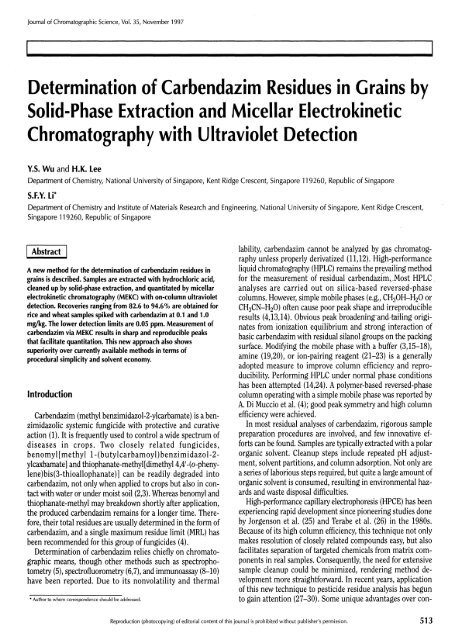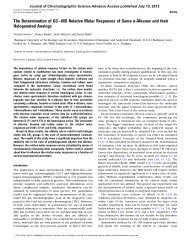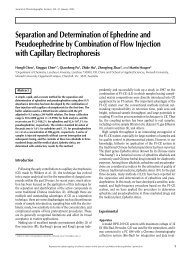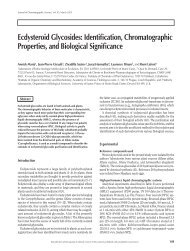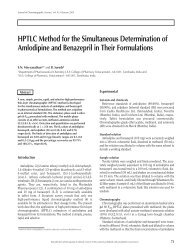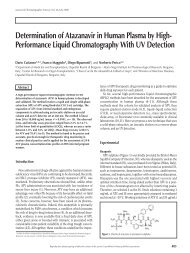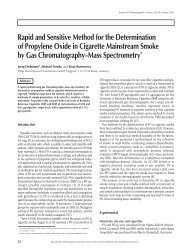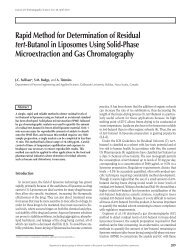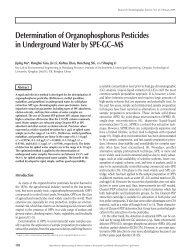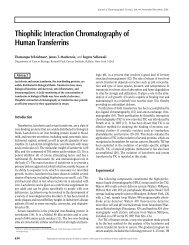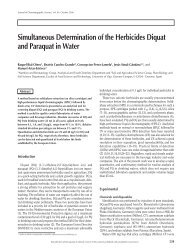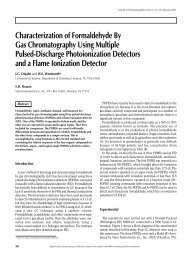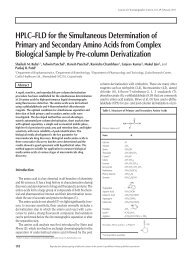Determination of Carbendazim Residues in Grains by Solid-Phase ...
Determination of Carbendazim Residues in Grains by Solid-Phase ...
Determination of Carbendazim Residues in Grains by Solid-Phase ...
You also want an ePaper? Increase the reach of your titles
YUMPU automatically turns print PDFs into web optimized ePapers that Google loves.
Journal <strong>of</strong> Chromatographic Science, Vol. 35, November 1997<br />
<strong>Determ<strong>in</strong>ation</strong> <strong>of</strong> <strong>Carbendazim</strong> <strong>Residues</strong> <strong>in</strong> Gra<strong>in</strong>s <strong>by</strong><br />
<strong>Solid</strong>-<strong>Phase</strong> Extraction and Micellar Electrok<strong>in</strong>etic<br />
Chromatography with Ultraviolet Detection<br />
Y.S. Wu and H.K. Lee<br />
Department <strong>of</strong> Chemistry, National University <strong>of</strong> S<strong>in</strong>gapore, Kent Ridge Crescent, S<strong>in</strong>gapore 119260, Republic <strong>of</strong> S<strong>in</strong>gapore<br />
S.F.Y. Li*<br />
Department <strong>of</strong> Chemistry and Institute <strong>of</strong> Materials Research and Eng<strong>in</strong>eer<strong>in</strong>g, National University <strong>of</strong> S<strong>in</strong>gapore, Kent Ridge Crescent,<br />
S<strong>in</strong>gapore 119260, Republic <strong>of</strong> S<strong>in</strong>gapore<br />
Abstract<br />
A new method for the determ<strong>in</strong>ation <strong>of</strong> carbendazim residues <strong>in</strong><br />
gra<strong>in</strong>s is described. Samples are extracted with hydrochloric acid,<br />
cleaned up <strong>by</strong> solid-phase extraction, and quantitated <strong>by</strong> micellar<br />
electrok<strong>in</strong>etic chromatography (MEKC) with on-column ultraviolet<br />
detection. Recoveries rang<strong>in</strong>g from 82.6 to 94.6% are obta<strong>in</strong>ed for<br />
rice and wheat samples spiked with carbendazim at 0.1 and 1.0<br />
mg/kg. The lower detection limits are 0.05 ppm. Measurement <strong>of</strong><br />
carbendazim via MEKC results <strong>in</strong> sharp and reproducible peaks<br />
that facilitate quantitation. This new approach also shows<br />
superiority over currently available methods <strong>in</strong> terms <strong>of</strong><br />
procedural simplicity and solvent economy.<br />
Introduction<br />
<strong>Carbendazim</strong> (methyl benzimidazol-2-ylcarbamate) is a benzimidazolic<br />
systemic fungicide with protective and curative<br />
action (1). It is frequently used to control a wide spectrum <strong>of</strong><br />
diseases <strong>in</strong> crops. Two closely related fungicides,<br />
benomyl[methyl l-(butylcarbamoyl)benzimidazol-2ylcaxbamate]<br />
and thiophanate-methyl [dimethyl 4,4'-(o-phenylene)bis(3-thioallophanate)]<br />
can be readily degraded <strong>in</strong>to<br />
carbendazim, not only when applied to crops but also <strong>in</strong> contact<br />
with water or under moist soil (2,3). Whereas benomyl and<br />
thiophanate-methyl may breakdown shortly after application,<br />
the produced carbendazim rema<strong>in</strong>s for a longer time. Therefore,<br />
their total residues are usually determ<strong>in</strong>ed <strong>in</strong> the form <strong>of</strong><br />
carbendazim, and a s<strong>in</strong>gle maximum residue limit (MRL) has<br />
been recommended for this group <strong>of</strong> fungicides (4).<br />
<strong>Determ<strong>in</strong>ation</strong> <strong>of</strong> carbendazim relies chiefly on chromatographic<br />
means, though other methods such as spectrophotometry<br />
(5), spectr<strong>of</strong>luorometry (6,7), and immunoassay (8-10)<br />
have been reported. Due to its nonvolatility and thermal<br />
* Author to whom correspondence should be addressed.<br />
lability, carbendazim cannot be analyzed <strong>by</strong> gas chromatography<br />
unless properly derivatized (11,12). High-performance<br />
liquid chromatography (HPLC) rema<strong>in</strong>s the prevail<strong>in</strong>g method<br />
for the measurement <strong>of</strong> residual carbendazim. Most HPLC<br />
analyses are carried out on silica-based reversed-phase<br />
columns. However, simple mobile phases (e.g., CH 3OH-H 2O or<br />
CH 3CN-H 2O) <strong>of</strong>ten cause poor peak shape and irreproducible<br />
results (4,13,14). Obvious peak broaden<strong>in</strong>g and-tail<strong>in</strong>g orig<strong>in</strong>ates<br />
from ionization equilibrium and strong <strong>in</strong>teraction <strong>of</strong><br />
basic carbendazim with residual silanol groups on the pack<strong>in</strong>g<br />
surface. Modify<strong>in</strong>g the mobile phase with a buffer (3,15-18),<br />
am<strong>in</strong>e (19,20), or ion-pair<strong>in</strong>g reagent (21-23) is a generally<br />
adopted measure to improve column efficiency and reproducibility.<br />
Perform<strong>in</strong>g HPLC under normal phase conditions<br />
has been attempted (14,24). A polymer-based reversed-phase<br />
column operat<strong>in</strong>g with a simple mobile phase was reported <strong>by</strong><br />
A. Di Muccio et al. (4); good peak symmetry and high column<br />
efficiency were achieved.<br />
In most residual analyses <strong>of</strong> carbendazim, rigorous sample<br />
preparation procedures are <strong>in</strong>volved, and few <strong>in</strong>novative efforts<br />
can be found. Samples are typically extracted with a polar<br />
organic solvent. Cleanup steps <strong>in</strong>clude repeated pH adjustment,<br />
solvent partitions, and column adsorption. Not only are<br />
a series <strong>of</strong> laborious steps required, but quite a large amount <strong>of</strong><br />
organic solvent is consumed, result<strong>in</strong>g <strong>in</strong> environmental hazards<br />
and waste disposal difficulties.<br />
High-performance capillary electrophoresis (HPCE) has been<br />
experienc<strong>in</strong>g rapid development s<strong>in</strong>ce pioneer<strong>in</strong>g studies done<br />
<strong>by</strong> Jorgenson et al. (25) and Terabe et al. (26) <strong>in</strong> the 1980s.<br />
Because <strong>of</strong> its high column efficiency, this technique not only<br />
makes resolution <strong>of</strong> closely related compounds easy, but also<br />
facilitates separation <strong>of</strong> targeted chemicals from matrix components<br />
<strong>in</strong> real samples. Consequently, the need for extensive<br />
sample cleanup could be m<strong>in</strong>imized, render<strong>in</strong>g method development<br />
more straightforward. In recent years, application<br />
<strong>of</strong> this new technique to pesticide residue analysis has begun<br />
to ga<strong>in</strong> attention (27-30). Some unique advantages over con-<br />
Reproduction (photocopy<strong>in</strong>g) <strong>of</strong> editorial content <strong>of</strong> this journal is prohibited without publisher's permission. 513
ventional chromatographic methods have been noted. Wigfield<br />
and coworkers (31) reported residue measurement <strong>of</strong> two<br />
bipyridylium herbicides (paraquat and diquat) <strong>in</strong> potatoes <strong>by</strong><br />
capillary zone electrophoresis (CZE). Detection could be done<br />
free <strong>of</strong> <strong>in</strong>terferences from coextractives. Krynitsky et al. (32)<br />
described determ<strong>in</strong>ation <strong>of</strong> five sulfonylurea herbicides <strong>in</strong><br />
gra<strong>in</strong>s <strong>by</strong> micellar electrok<strong>in</strong>etic chromatography (MEKC).<br />
The method claimed to be faster and more sensitive than the<br />
approved HPLC method.<br />
In this study, a new way to determ<strong>in</strong>e residual levels <strong>of</strong> carbendazim<br />
<strong>in</strong> gra<strong>in</strong>s was developed. Samples were extracted <strong>in</strong><br />
an acidic aqueous medium, purified and concentrated with a<br />
C 18 reversed-phase cartridge, and f<strong>in</strong>ally quantitated <strong>by</strong> MEKC.<br />
Through the comb<strong>in</strong>ation <strong>of</strong> solid-phase extraction (SPE) and<br />
MEKC, sample pretreatment was simplified, and reproducible<br />
detection <strong>of</strong> carbendazim was achieved.<br />
Experimental<br />
Reagents and materials<br />
<strong>Carbendazim</strong> standard was purchased from Chem Service<br />
(West Chester, PA). A 100-μg/mL stock solution was prepared<br />
<strong>by</strong> dissolv<strong>in</strong>g the standard <strong>in</strong> HPLC-grade methanol. Work<strong>in</strong>g<br />
standards were prepared <strong>by</strong> dilut<strong>in</strong>g the stock solution with an<br />
appropriate CE buffer.<br />
Sodium dihydrogen phosphate dihydrate, sodium carbonate<br />
monohydrate, and sodium dodecyl sulphate (SDS) were obta<strong>in</strong>ed<br />
from Fluka (Buchs, Switzerland). Sodium hydroxide<br />
and concentrated hydrochloric acid were supplied <strong>by</strong> BDH<br />
(Poole, UK). Purified water was prepared with a Milli-Q system<br />
(Millipore, Bedford, MA). SPE cartridges conta<strong>in</strong><strong>in</strong>g 500 mg C 18<br />
bonded sorbent were obta<strong>in</strong>ed from Whatman (Clifton, NJ)<br />
Instruments<br />
A laboratory-built CE system was used to carry out experiments.<br />
The system <strong>in</strong>cluded an LS30-2R4-3/3.5 high-voltage<br />
power supply (High Voltage Technology, New York, NY), a<br />
modified MicroUVIS20 detector (Carlo Erba, Milan, Italy)<br />
with wavelength set at 210 nm, and an LCI-100 <strong>in</strong>tegrator<br />
(Perk<strong>in</strong>-Elmer, Norwalk, CT). Separation was performed on a<br />
fused-silica capillary (50-μm i.d.; 375-μm o.d.; total length, 55<br />
cm; effective length, 45 cm) from Polymicro Technologies<br />
(Phoenix, AZ). The detection w<strong>in</strong>dow was made <strong>by</strong><br />
burn<strong>in</strong>g <strong>of</strong>f a small section <strong>of</strong> outer coat<strong>in</strong>g. The column<br />
was pretreated <strong>by</strong> first flush<strong>in</strong>g with 1M NaOH for 20 m<strong>in</strong><br />
followed <strong>by</strong> 10 m<strong>in</strong> with 0.1M NaOH, 5 m<strong>in</strong> with Millipore<br />
water, and f<strong>in</strong>ally 20 m<strong>in</strong> with runn<strong>in</strong>g buffer. All CE<br />
buffers and sample solutions were filtered through 0.45pm<br />
nylon filter devices. Samples were <strong>in</strong>jected <strong>in</strong>to the<br />
capillary <strong>by</strong> gravity with an <strong>in</strong>jection time <strong>of</strong> 10 s and an<br />
<strong>in</strong>jection height <strong>of</strong> 10 cm. All experiments were carried<br />
out under ambient temperature.<br />
Sample preparation<br />
F<strong>in</strong>ely ground gra<strong>in</strong>s (20 g) were weighed <strong>in</strong>to a 250-mL<br />
conical flask. 50 mL 1M hydrochloric acid was added, and<br />
514<br />
Journal <strong>of</strong> Chromatographic Science, Vol. 35, November 1997<br />
the mixture was stirred with a magnetic stirrer for 30 m<strong>in</strong>. The<br />
extract was vacuum-filtered through a Whatman filtration assembly.<br />
The filter cake was mixed aga<strong>in</strong> with 50 mL 1M HC1,<br />
stirred for another 30 m<strong>in</strong>, and filtered. The comb<strong>in</strong>ed flitrate<br />
was neutralized <strong>by</strong> slowly add<strong>in</strong>g sodium carbonate powder<br />
until release <strong>of</strong> carbon dioxide ceased. The result<strong>in</strong>g solution<br />
was centrifuged for 5 m<strong>in</strong> at 7000 rpm to remove sediments.<br />
The supernatant (approximately 95 mL) was then ready for<br />
subsequent SPE.<br />
SPE cleanup<br />
The Whatman ODS-2 cartridge was connected to a vacuum<br />
manifold. The cartridge was preconditioned <strong>by</strong> pass<strong>in</strong>g 5 mL<br />
methanol and then 10 mL Millipore water through it. The<br />
sample solution was loaded <strong>in</strong>to a separat<strong>in</strong>g funnel that was<br />
connected to the SPE cartridge. A vacuum was applied to keep<br />
the column flow rate at 3 mL/m<strong>in</strong>. When all the solution had<br />
passed through the cartridge, 20 mL <strong>of</strong> Millipore water was<br />
used to r<strong>in</strong>se the cartridge. The wash<strong>in</strong>g was discarded.<br />
F<strong>in</strong>ally, 2 mL <strong>of</strong> methanol was employed to desorb the<br />
cartridge. The eluate was collected <strong>in</strong> a small glass vial. This<br />
methanol solution was evaporated to near dryness <strong>by</strong><br />
<strong>in</strong>troduc<strong>in</strong>g a gentle stream <strong>of</strong> nitrogen, and then 1 mL <strong>of</strong><br />
low-ionic-strength buffer was added. The solution was sonicated<br />
prior to CE quantitation.<br />
Sample spik<strong>in</strong>g trials<br />
After a 20-g sample <strong>of</strong> f<strong>in</strong>ely milled gra<strong>in</strong> (rice or wheat) was<br />
placed <strong>in</strong> a conical flask, an appropriate volume <strong>of</strong> carbendazim<br />
stock standard (100 μg/mL <strong>in</strong> methanol) was added.<br />
This spiked sample was blended and allowed to air dry. Sample<br />
extraction, cleanup, and CE quantitation were done as usual.<br />
Recovery was obta<strong>in</strong>ed <strong>by</strong> compar<strong>in</strong>g the amounts that were<br />
found with the amounts that were added (based on the external<br />
standard method).<br />
Results and Discussion<br />
Migration behavior <strong>of</strong> carbendazim<br />
<strong>Carbendazim</strong> is a weak base. Therefore it can undergo protonation<br />
to form the correspond<strong>in</strong>g cation. Initially, CZE was<br />
attempted to analyze this compound. With 20mM HAc-NaAc<br />
Table I. Effect <strong>of</strong> Surfactant Concentration on Peak Height and<br />
Column Efficiency for <strong>Carbendazim</strong>*<br />
SDS (mM) Average peak height (mm) Migration time (m<strong>in</strong>) Plate number †<br />
20 14.2 ± 0.4 4.38 ± 0.03 4.5 x 10 4<br />
40 26.0 ± 0.5 6.19 ±0.04 1.9 x10 s<br />
60 33.8 ± 0.7 7.22 ±0.05 2.6 x 10 s<br />
80 36.0 ± 1.0 8.02 ± 0.05 3.2 x 10 5<br />
* Buffer: 40mM sodium phosphate at pH 7.0; voltage: +18 kV; <strong>in</strong>jected sample: 10 ppm<br />
carbendazim dissolved <strong>in</strong> runn<strong>in</strong>g buffer with a correspond<strong>in</strong>g concentration <strong>of</strong> SDS. Data<br />
are from three replicates.<br />
+<br />
Plate number was calculated accord<strong>in</strong>g to the formula: N = 5.54 x (migration time/peak<br />
width at half-height) 2<br />
.
Journal <strong>of</strong> Chromatographic Science, Vol. 35, November 1997<br />
buffer at pH 4-6, carbendazim could be detected as a broad,<br />
tail<strong>in</strong>g peak ahead <strong>of</strong> electroosmotic flow (electropherogram<br />
not shown). Hence this mode was deemed unsuitable for<br />
residual analysis. On the contrary, when analysis <strong>of</strong> carbendazim<br />
was performed us<strong>in</strong>g MEKC mode (phosphate buffer<br />
with SDS surfactant), a symmetric peak with much better efficiency<br />
could be obta<strong>in</strong>ed. The detection was highly reproducible.<br />
From the data <strong>in</strong> Table I, it can be seen that variation<br />
<strong>in</strong> migration time was less than 1%, and deviation <strong>of</strong> peak<br />
height was with<strong>in</strong> 3%. Follow<strong>in</strong>g the column flush<strong>in</strong>g procedure<br />
as described, the day-to-day variation <strong>in</strong> migration time<br />
was better than 3%, and the deviation <strong>of</strong> peak response was less<br />
than 5%. We believe two factors can account for the excellent<br />
column efficiency and reproducibility. First, because MEKC is<br />
conducted <strong>in</strong> a well-buffered system, ionization <strong>of</strong> carbendazim<br />
could be suppressed (thus peak broaden<strong>in</strong>g was m<strong>in</strong>imized).<br />
Second, unlike <strong>in</strong> silica-based HPLC, <strong>in</strong> which a strong<br />
<strong>in</strong>teraction exists between the basic carbendazim and residual<br />
silanol groups on the stationary phase, SDS micelles<br />
(pseudeophase) <strong>in</strong> MEKC have no such <strong>in</strong>teraction mechanism<br />
with the solute, and peak tail<strong>in</strong>g is avoided.<br />
Optimization <strong>of</strong> MEKC parameters<br />
As <strong>in</strong> many previous CE separations, on-column ultraviolet<br />
(UV) detection was used to detect the peaks. An <strong>in</strong>herent<br />
drawback <strong>of</strong> this detection method is its low concentration<br />
sensitivity because the optical path length is limited to the<br />
<strong>in</strong>ner diameter <strong>of</strong> the capillary. This loss <strong>of</strong> detection sensitivity<br />
Figure 1. Relative peak height <strong>of</strong> carbendazim with various <strong>in</strong>jection matrices.<br />
Runn<strong>in</strong>g buffer: 40mM phosphate with 60mM SDS (pH = 7.0); applied voltage:<br />
18 kV; <strong>in</strong>jected sample: 10 ppm carbendazim <strong>in</strong> correspond<strong>in</strong>g medium.<br />
can be partially compensated through careful optimization<br />
<strong>of</strong> parameters. From our <strong>in</strong>vestigation, two factors (SDS<br />
concentration <strong>in</strong> the runn<strong>in</strong>g buffer and the sample <strong>in</strong>jection<br />
medium) were found to have significant impacts on column efficiency<br />
and detection sensitivity. In the follow<strong>in</strong>g discussion,<br />
peak height rather than peak area is used to evaluate detection<br />
sensitivity because it better reflects the changes <strong>in</strong> column<br />
efficiency (33).<br />
Table I illustrates the effect <strong>of</strong> SDS concentration on the<br />
peak height and column efficiency <strong>of</strong> carbendazim. When SDS<br />
concentration <strong>in</strong> the runn<strong>in</strong>g buffer <strong>in</strong>creased from 20 to<br />
80mM, peak height response from the same amount <strong>of</strong>-carbendazim<br />
<strong>in</strong>creased about 150%, whereas column efficiency<br />
<strong>in</strong>creased sixfold. The <strong>in</strong>creases <strong>in</strong> efficiency and detection<br />
sensitivity with <strong>in</strong>creas<strong>in</strong>g surfactant concentration have been<br />
observed elsewhere (33-35). It has been attributed to the reduction<br />
<strong>of</strong> resistance to mass transfer due to shorten<strong>in</strong>g <strong>of</strong> <strong>in</strong>termicelle<br />
distance (34) or mitigation <strong>of</strong> longitud<strong>in</strong>al diffusion<br />
because <strong>of</strong> <strong>in</strong>creased capacity factor and lower<strong>in</strong>g <strong>of</strong> the diffusion<br />
coefficient (33). Though it is possible to achieve higher<br />
efficiency <strong>by</strong> further <strong>in</strong>creas<strong>in</strong>g micellar concentration, higher<br />
SDS concentration caused worsen<strong>in</strong>g <strong>of</strong> the signal-to-noise<br />
ratio due to heat dissipation.<br />
Choos<strong>in</strong>g a suitable medium for sample <strong>in</strong>jection is another<br />
factor worthy <strong>of</strong> consideration. The <strong>in</strong>fluence <strong>of</strong> different<br />
sample media on the peak height response <strong>of</strong> carbendazim is<br />
shown <strong>in</strong> Figure 1. When carbendazim was dissolved <strong>in</strong> solvents<br />
such as methanol and methanol-water mixtures, the result<strong>in</strong>g<br />
peak height was very low. This phenomenon may be expla<strong>in</strong>ed<br />
<strong>in</strong> the follow<strong>in</strong>g manner. When a sample conta<strong>in</strong><strong>in</strong>g a high<br />
content <strong>of</strong> organic solvent is <strong>in</strong>troduced <strong>in</strong>to the capillary, the<br />
organic solvent <strong>in</strong> the sample plug diffuses toward the surround<strong>in</strong>g<br />
buffer solution, caus<strong>in</strong>g a breakdown <strong>of</strong> neighbor<strong>in</strong>g<br />
micelles. This means that micelles will disappear along quite a<br />
long segment <strong>of</strong> capillary. Consequently, it takes longer for<br />
the solute to be <strong>in</strong>corporated <strong>in</strong>to micelles. This results <strong>in</strong> a<br />
significant dilution <strong>of</strong> the sample band and loss <strong>of</strong> detection<br />
sensitivity. It was found that dissolv<strong>in</strong>g carbendazim <strong>in</strong> a lowionic-strength<br />
buffer conta<strong>in</strong><strong>in</strong>g SDS was a favorable choice.<br />
Peak height reached its maximum when the sample was dissolved<br />
<strong>in</strong> 20mM phosphate buffer with 60mM SDS. A possible<br />
explanation is that, under such conditions, carbendazim was<br />
largely <strong>in</strong>corporated <strong>in</strong>to the SDS micelle and behaved as a<br />
charged molecule. Thus some sample stack<strong>in</strong>g effect might<br />
exist that leads to solute zone sharpen<strong>in</strong>g and higher sensitivity.<br />
Other MEKC parameters such as ionic strength, buffer pH,<br />
and voltage were selected <strong>by</strong> balanc<strong>in</strong>g the system reproducibility,<br />
signal noise level, and analysis time. The f<strong>in</strong>al optimized<br />
conditions were as follows: buffer, 40mM phosphate with<br />
60mM SDS (pH = 7.0); voltage, 18 kV. The sample for <strong>in</strong>jection<br />
was dissolved <strong>in</strong> 20mM sodium phosphate with 60mM SDS.<br />
Under these conditions, the lowest detection limit for carbendazim<br />
was 1.0 ppm. By <strong>in</strong>ject<strong>in</strong>g a series <strong>of</strong> carbendazim standards,<br />
the concentration <strong>of</strong> which ranged from 1.0 to 20 ppm,<br />
a l<strong>in</strong>ear l<strong>in</strong>e was established as: y = 3948x + 68.9 (square <strong>of</strong> the<br />
correlation coefficient [r 2<br />
] = 0.998), where y is the peak area<br />
count, and x is the carbandazim concentration <strong>in</strong> ppm. Further<br />
expansion <strong>of</strong> the l<strong>in</strong>ear range is difficult due to the limited sol-<br />
515
Figure 2. Chromatograms <strong>of</strong> carbendazim standard and spiked and controlled samples. Capillary:<br />
55 cm x 50 μm fused silica; runn<strong>in</strong>g buffer: 60mM SDS <strong>in</strong> 40mM phosphate (pH 7.0); <strong>in</strong>jection<br />
media: 60mM SDS <strong>in</strong> 20mM phosphate; applied voltage: 18 kV; current: 52 μA. (A) <strong>Carbendazim</strong><br />
standard, (B) spiked rice, (C) controlled rice, (D) spiked wheat, and (E) controlled wheat. Rice and<br />
wheat samples were spiked at 1.0 ppm. Detection was performed after 20-fold concentration <strong>by</strong><br />
SPE. Arrows <strong>in</strong>dicate expected migration time for carbendazim.<br />
Table II. Recoveries <strong>of</strong> <strong>Carbendazim</strong> from Fortified<br />
Gra<strong>in</strong> Commodities*<br />
0.1 ppm level 1.0 ppm level<br />
Average Coefficient<br />
Gra<strong>in</strong> recovery (%) <strong>of</strong> variation<br />
Average Coefficient<br />
recovery (%) <strong>of</strong> variation<br />
Rice 90.1 7.5 93.1 4.4<br />
Wheat 82.6 8.6 94.6 5.6<br />
* Three replicates, each level.<br />
ubility <strong>of</strong> carbendazim <strong>in</strong> water. It should be noted that even<br />
under optimized conditions, the detection sensitivity was still<br />
<strong>in</strong>adequate for the determ<strong>in</strong>ation <strong>of</strong> low-level carbendazim<br />
residues. Therefore, sample enrichment was necessary.<br />
Sample extraction and cleanup<br />
<strong>Carbendazim</strong> forms a water-soluble salt at low pH, thus<br />
<strong>of</strong>fer<strong>in</strong>g the possibility <strong>of</strong> extraction <strong>of</strong> this fungicide <strong>in</strong><br />
an acidic medium. Accord<strong>in</strong>g to our experiments, when 1M<br />
hydrochloric acid was used to soak gra<strong>in</strong> samples, carbendazim<br />
was effectively extracted. Simply neutraliz<strong>in</strong>g the extract<br />
516<br />
Journal <strong>of</strong> Chromatographic Science, Vol. 35, November 1997<br />
resulted <strong>in</strong> an aqueous solution that could be<br />
conveniently loaded onto a reversed-phase SPE<br />
cartridge. Sample enrichment and purification<br />
were achieved simultaneously.<br />
By gradually load<strong>in</strong>g a dilute carbendazim<br />
standard solution onto the ODS-2 SPE cartridge<br />
and monitor<strong>in</strong>g the eluted fractions, it<br />
was concluded that the breakthrough volume<br />
for carbendazim was over 200 mL. This <strong>in</strong>dicated<br />
that the cartridge could provide adequate<br />
preconcentration, which could facilitate subsequent<br />
CE detection.<br />
Several factors such as organic solvent content<br />
and ionic strength had impacts on CE<br />
performance for carbendazim. Efforts had to be<br />
made dur<strong>in</strong>g sample cleanup to control these<br />
factors. After load<strong>in</strong>g the sample solution onto<br />
the cartridge, a wash<strong>in</strong>g step was necessary to<br />
remove possible coextracted substances and<br />
salt components. The elim<strong>in</strong>ation <strong>of</strong> salts<br />
helped to guarantee a uniform ionic strength<br />
<strong>in</strong> the concentrated solution. After SPE<br />
cleanup, the concentrated sample was transferred<br />
to a methanolic medium, which had to<br />
be evaporated. The result<strong>in</strong>g residues were f<strong>in</strong>ally<br />
dissolved <strong>in</strong> optimized buffer. By apply<strong>in</strong>g<br />
SPE, a 20-fold concentration <strong>of</strong> the sample was<br />
obta<strong>in</strong>ed. When 1.0 μg carbendazim standard<br />
was fortified to a 20-g (0.05 ppm) gra<strong>in</strong> sample<br />
follow<strong>in</strong>g the same sample treatment and<br />
MEKC analysis procedure, carbendazim was<br />
still detectable with a signal-to-noise ratio<br />
greater than 5; this <strong>in</strong>dicates that the detection<br />
limits were comparable to most HPLC<br />
methods.<br />
It is worth not<strong>in</strong>g that some advantages have<br />
been ga<strong>in</strong>ed <strong>by</strong> <strong>in</strong>troduc<strong>in</strong>g this new sample extraction and<br />
cleanup method. First, consumption <strong>of</strong> organic solvent was<br />
greatly reduced. Whereas most methods require at least several<br />
hundred milliliters <strong>of</strong> solvent <strong>in</strong> steps such as sample extraction,<br />
solvent partition<strong>in</strong>g, and column elution, this method <strong>in</strong>volved<br />
only a few milliliters <strong>of</strong> methanol for the purposes <strong>of</strong><br />
SPE cartridge precondition<strong>in</strong>g and desorption. Second, the<br />
cleanup procedures are significantly simplified. In traditional<br />
methods, repetitive solvent partitions and evaporations are<br />
needed. With SPE, these laborious steps were elim<strong>in</strong>ated, and<br />
emulsification problems were prevented.<br />
Method validation<br />
Figure 2 presents chromatograms <strong>of</strong> the carbendazim standards,<br />
spiked samples, and controlled samples <strong>of</strong> rice and wheat<br />
(1 ppm spik<strong>in</strong>g level with 20-fold concentration after SPE).<br />
From these chromatograms, it can be seen that most sample<br />
matrix components elute closely follow<strong>in</strong>g the electroosmotic<br />
flow. This met our expectation because only highly polar components<br />
would be extracted with dilute acid. Wheat samples<br />
seemed to conta<strong>in</strong> more complicated coextractives, but this did<br />
not cause any serious <strong>in</strong>terference problems.
Journal <strong>of</strong> Chromatographic Science, Vol. 35, November 1997<br />
Table II lists the results <strong>of</strong> standard addition <strong>of</strong> carbendazim<br />
<strong>in</strong> rice and wheat samples at 0.1 and 1 ppm levels. The maximum<br />
residual limits for carbendazim <strong>in</strong> cereals vary among<br />
different countries, but they are typically <strong>in</strong> the range <strong>of</strong> 0.1-1.0<br />
ppm. The satisfactory recoveries show that this new method is<br />
suitable for detect<strong>in</strong>g carbendazim residues <strong>in</strong> gra<strong>in</strong> samples.<br />
Conclusion<br />
In this study, determ<strong>in</strong>ation <strong>of</strong> carbendazim residues <strong>in</strong><br />
gra<strong>in</strong>s <strong>by</strong> HPCE with SPE was demonstrated. With optimization<br />
<strong>of</strong> sample preparation and CE parameters, detection limits<br />
comparable to common HPLC methods were obta<strong>in</strong>ed. The<br />
new method was highly reproducible, required very little organic<br />
solvent, and was procedurally simplified as compared<br />
with conventional HPLC approaches.<br />
Acknowledgment<br />
The authors wish to thank the National University <strong>of</strong> S<strong>in</strong>gapore<br />
for provid<strong>in</strong>g f<strong>in</strong>ancial support for this study.<br />
References<br />
1. The Pesticide Manual, 10th ed. C. Toml<strong>in</strong>, Ed. British Crop Protection<br />
Council and Royal Society <strong>of</strong> Chemistry, U.K., 1994, pp.<br />
149-50.<br />
2. F.J. Baude, J.A. Gard<strong>in</strong>er, and J.C.Y. Han. Characterization <strong>of</strong><br />
residues on plants follow<strong>in</strong>g foliar spray application <strong>of</strong> benomyl.<br />
]. Agric. Food Chem. 21:1084-90 (1973).<br />
3. R.P. S<strong>in</strong>gh and M. Chiba. Solubility <strong>of</strong> benomyl <strong>in</strong> water at different<br />
pHs and its conversion to methyl 2-benzimidazol carbamate,<br />
3-butyl-2,4-dioxo[1,2-a]-s-triaz<strong>in</strong>obenzimidazole, and 1-(2benzimidazoyl)-3-n-butylurea.<br />
J. Agric. Food Chem. 33: 63-67<br />
(1985).<br />
4. A. Di Muccio, I. Camoni, M. Ventriglia, D.A. Barb<strong>in</strong>i, M. Mauro,<br />
P. Pelosi, T. Generali, A. Ausili, and S. Girolimetti. Simplified<br />
cleanup for the determ<strong>in</strong>ation <strong>of</strong> benzimidazolic fungicides <strong>by</strong><br />
high-performance liquid chromatography with UV detection, j.<br />
Chromatogr. 697:145-52 (1995).<br />
5. A. Monica-Pifarre and M. Xirau-Vayreda. Study <strong>of</strong> carbendazim<br />
residue accumulation on greenhouse and field grown strawberries,<br />
after successive treatments with benomyl. J. Assoc. Off.<br />
Anal. Chem. 73: 553-56 (1990).<br />
6. F. Garcia-Sanchez and C. Cruces-Blanco. Spectr<strong>of</strong>luorometric<br />
determ<strong>in</strong>ation <strong>of</strong> pesticide residue mixture <strong>by</strong> isodifferential<br />
derivative spectroscopy. Anal. Chem. 60: 323-28 (1988).<br />
7. J. Sancenon and M. dela Guardia. Micellar enhanced fluorometric<br />
determ<strong>in</strong>ation <strong>of</strong> carbendazim <strong>in</strong> natural waters. Anal.<br />
Chim. Acta 287:49-57(1994).<br />
8. W.H. Newsome and J.B. Shields. A radioimmunoassay for<br />
benomyl and methyl 2-benzimidazole carbamate on food crops,<br />
j. Agric. Food Chem. 29: 220-22 (1981).<br />
9. J.A. Itak, M.Y. Selisker, S.W. Jourdan, J.R. Fleeker, and D.P.<br />
Herzog. <strong>Determ<strong>in</strong>ation</strong> <strong>of</strong> benomyl (as carbendazim) and carbendazim<br />
<strong>in</strong> water, soil and fruit juice <strong>by</strong> a magnetic particlebased<br />
immunoassay. J. Agric. Food Chem. 41: 2329-32 (1993).<br />
10. R.J. Bushway, B.E.S. Young, L.R. Paradis, L.B. Perk<strong>in</strong>s, S.K. Mart<strong>in</strong>,<br />
and M.P. Brown. <strong>Determ<strong>in</strong>ation</strong> <strong>of</strong> methyl 2-benzimidazole carbamate<br />
<strong>in</strong> bulk fruit juice concentrates <strong>by</strong> competitive-<strong>in</strong>hibition<br />
enzyme immunoassay.J.AOAC Int. 77:1237-43 (1994).<br />
11. G.H. Tjan and J.T.A. Jansen. Gas-liquid chromatographic determ<strong>in</strong>ation<br />
<strong>of</strong> thiabendazole and methyl 2-benzimidazole carbamate<br />
<strong>in</strong> fruits and crops. J. Assoc. Off. Anal. Chem. 62: 769-73<br />
(1979).<br />
12. H. Ste<strong>in</strong>wandter. Chemical derivatization <strong>in</strong> residue analysis. I.<br />
Gas chromatographic determ<strong>in</strong>ation <strong>of</strong> carbendazim after alkylation<br />
with diazomethane and diazoethane. Fresenius' Z. Anal.<br />
Chem. 321: 599-600 (1985).<br />
13. L.F. Lopez, A.G. Lopez, and M.V. Riba. HPLC method for simultaneous<br />
determ<strong>in</strong>ation <strong>of</strong> fungicides: <strong>Carbendazim</strong>, metalaxyl,<br />
folpet, and propiconazole <strong>in</strong> must and w<strong>in</strong>e. J. Agric. Food Chem.<br />
37:684-87(1989).<br />
14. S.D. Regisrolle and G.M. Bauville. High-performance liquid<br />
chromatographic method for the determ<strong>in</strong>ation <strong>of</strong> carbendazim<br />
residues <strong>in</strong> crops, gra<strong>in</strong>s, and w<strong>in</strong>es with fluorescent detection.<br />
Pestic.Sci. 37:273-82 (1993).<br />
15. C.H. Lui, G.C. Mattern, X.B. Yu, and J.D. Rosen. <strong>Determ<strong>in</strong>ation</strong><br />
<strong>of</strong> benomyl <strong>by</strong> high-performance liquid chromatography/mass<br />
spectrometry/selected ion monitor<strong>in</strong>g. J. Agric. Food Chem. 38:<br />
167-71 (1990).<br />
16. T. Gomyo, M. Ozawa, and S. Kobayashi. Analytical method for<br />
determ<strong>in</strong>g the total content <strong>of</strong> methyl benzimidazole carbamate<br />
fungicides <strong>in</strong> water <strong>by</strong> column switch<strong>in</strong>g liquid chromatography<br />
mass spectrometry. Anal. Sci. 8:687-90 (1992).<br />
17. J.S. Dhoot and A.R. Delrosario. <strong>Determ<strong>in</strong>ation</strong> and confirmation<br />
<strong>of</strong> benomyl and carbendazim <strong>in</strong> water us<strong>in</strong>g high performance<br />
liquid chromatography and diode array detection. J. Chromatogr.<br />
645:178-81 (1993).<br />
18. R.P. S<strong>in</strong>gh and M. Chiba. Reversed phase liquid chromatographic<br />
method for the simultaneous determ<strong>in</strong>ation <strong>of</strong> benomyl and<br />
methyl 1 H-benzimidazol-2-ylcarbamate irrwettable powder formulations.<br />
). AOAC Int. 76: 1187-92 (1993).<br />
19. R.J. Bushway, H.L. Hurst, J. Kagabalasooriar, and L.B. Perk<strong>in</strong>s. <strong>Determ<strong>in</strong>ation</strong><br />
<strong>of</strong> carbendazim <strong>in</strong> blueberries <strong>by</strong> reversed phase<br />
high-performance liquid chromatography. J. Chromatogr. 587:<br />
321-24 (1991).<br />
20. P. Cano, J.L. Plaza, and D.L. Munoz. <strong>Determ<strong>in</strong>ation</strong> and persistence<br />
<strong>of</strong> several fungicides <strong>in</strong> postharvest treated apples dur<strong>in</strong>g<br />
their cold storage. J. Agric. Food Chem. 35: 144-47 (1987).<br />
21. D.M. Gilvydis and S.M. Walters. Ion-pair<strong>in</strong>g liquid chromatographic<br />
determ<strong>in</strong>ation <strong>of</strong> benzimidazole fungicides <strong>in</strong> foods. J.<br />
Assoc. Off. Anal. Chem. 73: 753-61 (1990).<br />
22. N. Aharonson, S.J. Lehotay, and M.A. Ibrahim. Supercritical fluid<br />
extraction and HPLC analysis <strong>of</strong> benzimidazole fungicides <strong>in</strong><br />
potato, apple and banana. J. Agric. Food Chem. 42: 2817-23<br />
(1994).<br />
23. A. Sann<strong>in</strong>o. Investigation <strong>in</strong>to contam<strong>in</strong>ation <strong>of</strong> processed fruit<br />
products <strong>by</strong> carbendazim, methyl thiophanate and thiabendazole.<br />
Food Chem. 52:57-61 (1995).<br />
24. C. Bicchi, F. Belliardo, L. Cantamessa, G. Gaspar<strong>in</strong>i, M. Icardi,<br />
and E. Sesia. Simultaneous determ<strong>in</strong>ation <strong>of</strong> benzimidazole fungicides<br />
<strong>by</strong> HPLC on apples, pears and their pulps. Pestic. Sci. 25:<br />
355-60 (1989).<br />
25. J.W. Jorgenson and K.D. Lukacs. Zone electrophoresis <strong>in</strong> open<br />
tubular glass capillaries. Anal. Chem. 53:1298-1302 (1981).<br />
26. S. Terabe, K. Otsuka, K. Ichikawa, A. Tsuchiya, and T. Ando.<br />
Electrok<strong>in</strong>etic separations with micellar solutions and open<br />
tubular capillaries. Anal. Chem. 56:111-13 (1984).<br />
27. G. D<strong>in</strong>elli, A. Bonetti, P. Catizone, and G.C. Gallettti. Separation<br />
and detection <strong>of</strong> herbicides <strong>in</strong> water <strong>by</strong> micellar electrok<strong>in</strong>etic<br />
capillary chromatography. J. Chromatogr. B 656: 275-80 (1994).<br />
28. H. Susse and H. Muller. Application <strong>of</strong> micellar electrok<strong>in</strong>etic<br />
capillary chromatography to the analysis <strong>of</strong> pesticides. Fresenius'J.<br />
Anal. Chem. 352:470-73 (1995).<br />
29. G. D<strong>in</strong>elli, A. Vicari, and V. Brandol<strong>in</strong>i. Detection and quantitation<br />
<strong>of</strong> sulfonylurea herbicides <strong>in</strong> soil at ppb level <strong>by</strong> capillary<br />
electrophoresis. J. Chromatogr. 700: 201-207 (1995).<br />
517
30. S.J. Richman, C.A. Walker, and S.M. Lee. Capillary electrophoresis-<br />
explor<strong>in</strong>g a new analytical tool for pesticide residue<br />
analysis. Abstr. Pap. Am. Chem. Soc. 210: 2- Agro (1995).<br />
31. Y.Y. Wigfield, K.A. McCormack, and R. Grant. Simultaneous determ<strong>in</strong>ation<br />
<strong>of</strong> residues <strong>of</strong> paraquat and diquat <strong>in</strong> potatoes us<strong>in</strong>g<br />
high performance capillary electrophoresis with ultraviolet detection.<br />
J. Agric. Food. Chem. 41: 2315-18 (1993).<br />
32. A.J. Krynitsky and D.M. Sw<strong>in</strong>eford. <strong>Determ<strong>in</strong>ation</strong> <strong>of</strong> sulfonylurea<br />
herbicides <strong>in</strong> gra<strong>in</strong>s <strong>by</strong> capillary electrophoresis. J. AOAC<br />
Int. 78:1091-96 (1995).<br />
33. Z.K. Shihabi and M.E. H<strong>in</strong>sdale. Sample matrix effects <strong>in</strong> mi<br />
518<br />
Journal <strong>of</strong> Chromatographic Science, Vol. 35, November 1997<br />
cellar electrok<strong>in</strong>etic capillary electrophoresis. J. Chromatogr. B<br />
669:75-83(1995).<br />
34. M.J. Sepaniak and R.O. Cole. Column efficiency <strong>in</strong> micellar electrok<strong>in</strong>etic<br />
capillary chromatography. Anal. Chem. 59: 472-76<br />
(1987).<br />
35. A.T. Balchunas and M.J. Sepaniak. Gradient elution for micellar<br />
electrok<strong>in</strong>etic capillary chromatography. Anal. Chem. 60: 617-21<br />
(1988).<br />
Manuscript accepted April 29, 1997.


